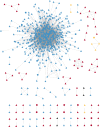HIV-1 molecular transmission network and drug resistance in Chongqing, China, among men who have sex with men (2018-2021)
- PMID: 37443039
- PMCID: PMC10339625
- DOI: 10.1186/s12985-023-02112-0
HIV-1 molecular transmission network and drug resistance in Chongqing, China, among men who have sex with men (2018-2021)
Abstract
Background: Over the past few years, HIV transmission among men who have sex with men (MSM) in China has increased significantly. Chongqing, located in the southwest of China, has the highest prevalence of HIV among MSM in the country.
Methods: Blood samples were taken from 894 MSM in Chongqing who had recently been diagnosed with HIV-1 infection and had not yet started getting treatment. In order to determine the distribution of HIV-1 subtypes, transmitted drug resistance, and assessments of molecularly transmitted clusters, we sequenced the Pol genes and employed them in phylogenetic analysis. The genetic distance between molecular clusters was 1.5%. To find potential contributing factors, logistic regression analyses were performed.
Results: Of the 894 HIV-1 pol sequences acquired from study participants, we discovered that CRF07_BC (73.6%) and CRF01_AE (19.6%) were the two most prevalent HIV-1 genotypes in Chongqing among MSM, accounting for 93.2% of all infections. In addition, CRF08_BC (1.1%), B subtype (1.0%), CRF55_01B (3.4%), and URF/Other subtypes (1.3%) were less frequently observed. Among MSM in Chongqing, transmitted drug resistance (TDR) was reported to be present at a rate of 5.6%. 48 clusters with 600 (67.1%, 600/894) sequences were found by analysis of the molecular transmission network. The distributions of people by age, sexual orientation, syphilis, and genotype were significantly differentially related to being in clusters, according to the multivariable logistic regression model.
Conclusion: Despite the low overall prevalence of TDR, the significance of genotypic drug resistance monitoring needs to be emphasized. CRF07_BC and CRF01_AE were the two main genotypes that created intricate molecular transmission networks. In order to prevent the expansion of molecular networks and stop the virus's spread among MSM in Chongqing, more effective HIV intervention plans should be introduced.
Keywords: Chongqing; Drug resistance; HIV-1 transmission network; MSM.
© 2023. The Author(s).
Conflict of interest statement
The authors declare no competing interests.
Figures


Similar articles
-
Analysis of genotype resistance and HIV-1 transmission risk in HIV-1-infected men who have sex with men in Guiyang, China.Immun Inflamm Dis. 2024 Nov;12(11):e70029. doi: 10.1002/iid3.70029. Immun Inflamm Dis. 2024. PMID: 39552198 Free PMC article.
-
Characterization of HIV-1 molecular epidemiology and transmitted drug-resistance in newly diagnosed HIV-infected patients in Sichuan, China.BMC Infect Dis. 2022 Jul 7;22(1):602. doi: 10.1186/s12879-022-07576-z. BMC Infect Dis. 2022. PMID: 35799101 Free PMC article.
-
Increase of RT-related transmitted drug resistance in non-CRF01_AE among HIV type 1-infected men who have sex with men in the 7 cities of China.J Acquir Immune Defic Syndr. 2015 Mar 1;68(3):250-5. doi: 10.1097/QAI.0000000000000467. J Acquir Immune Defic Syndr. 2015. PMID: 25469530
-
Molecular network characteristics and drug resistance analysis of 392 newly reported MSM HIV/AIDS cases in Chongqing, China.Front Public Health. 2024 Jun 6;12:1308784. doi: 10.3389/fpubh.2024.1308784. eCollection 2024. Front Public Health. 2024. PMID: 38903589 Free PMC article.
-
The prevalence, temporal trends, and geographical distribution of HIV-1 subtypes among men who have sex with men in China: A systematic review and meta-analysis.Epidemiol Infect. 2019 Jan;147:e83. doi: 10.1017/S0950268818003400. Epidemiol Infect. 2019. PMID: 30869019 Free PMC article.
Cited by
-
Analysis of HIV infection among voluntary blood donors based on HIV ELISA and nucleic acid detection.Am J Transl Res. 2024 Dec 15;16(12):7765-7773. doi: 10.62347/PFWG7249. eCollection 2024. Am J Transl Res. 2024. PMID: 39822531 Free PMC article.
-
Divergent transmission dynamics and drug resistance evolution of HIV-1 CRF01_AE and CRF07_BC in Tianjin, China (2013-2022).Virol J. 2025 May 8;22(1):137. doi: 10.1186/s12985-025-02704-y. Virol J. 2025. PMID: 40340650 Free PMC article.
-
Exploring Dynamic Changes in HIV-1 Molecular Transmission Networks and Key Influencing Factors: Cross-Sectional Study.JMIR Public Health Surveill. 2024 May 29;10:e56593. doi: 10.2196/56593. JMIR Public Health Surveill. 2024. PMID: 38810253 Free PMC article.
-
Characteristics of molecular epidemiology and transmitted drug resistance among newly diagnosed HIV-1 infections in Lishui, China from 2020 to 2023.Virol J. 2025 Apr 19;22(1):111. doi: 10.1186/s12985-025-02734-6. Virol J. 2025. PMID: 40253369 Free PMC article.
References
-
- GBD 2017 HIV collaborators. Global, regional, and national incidence, prevalence, and mortality, of HIV. 1980–2017, and forecasts to 2030, for 195 countries and territories: a systematic analysis for the Global Burden of Diseases, Injuries, and Risk Factors Study 2017. Lancet HIV. 2019;6:e831–59. - PMC - PubMed
MeSH terms
Grants and funding
- 2023MSXM113/Chongqing medical scientific research project
- 2022GDRC017/Chongqing medical scientific research project of Chongqing Health Commission and Science and Technology Bureau
- cstc2021jcyj-msxmX1171/Chongqing Natural Science Foundation Project
- cstc2021ycjh-bgzxm0097/Chongqing Talents Program for Innovative and Entrepreneurial Pioneers
- YWBF2022072/the first batch of key disciplines on public health in Chongqing
LinkOut - more resources
Full Text Sources
Medical
Miscellaneous

